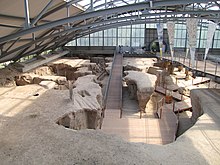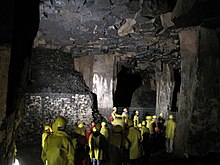Vulkanpark (Mayen-Koblenz district)



The volcano park in the Mayen-Koblenz district is a geopark founded in 1996 in the eastern Vulkaneifel . It extends around the Laacher See (between Brohl-Lützing , Andernach , Plaidt , Mendig and Mayen ). The volcano park in the district of Mayen-Koblenz and the Brohltal / Laacher See volcano park form the recognized national geopark Laacher See . The German Volcano Road connects the National Geopark Laacher See with the National Geopark Vulkaneifel over a distance of 280 kilometers. In addition, the volcano park is one of the masterpieces between the Rhine and Moselle .
description
The volcanic park uses various projects to show the volcanism of the Eifel, the formation of the landscape and the use of the volcanic raw materials basalt , pumice and tuff over the past 7,000 years. One focus is the use of the raw materials basalt and tuff in Roman antiquity. Visitors can experience this on volcanological, archaeological and industrial-historical projects, which are easily accessible through information boards and educational trails. The volcano park has a total of 25 stations that can be connected to each other for excursions. This is possible through four car routes, but also through hiking and cycling trails. The Vulkanpark-Radweg leads from Mayen to Andernach and passes numerous volcanological and archaeological projects in the volcanic park. Hiking trails such as the dream paths "Vulkanpfad" or the "Booser Doppelmaartour" link other stations in the volcano park.
On June 10, 2010, the volcano park was awarded the “European Union Prize for Cultural Heritage” by the monument protection organization Europa Nostra in the “Education, teaching, training and awareness raising” category for the protection and maintenance of cultural heritage in Europe . The prize had previously been awarded to the Meurin Roman Mine Volcano Park project in 2003 .
Vulkanpark stations
Blue route - Plaidt
- Central contact point between Plaidt and Saffig , information center and museum with exhibitions on the origins of the Eifel and the history of quarrying.
- Tuff deposits are preserved after the Laacher See volcanic eruption.
- Karmelenberg with Marienkapelle
- Roman tomb in Ochtendung
- Built from tufa quarried in the Meurin Roman mine.
Red route - Mendig
- Volcano Museum with information on the history of volcanism and the geological history of the region.
- Underground mining 32 meters below the city of Mendig in a cooled lava flow with an area of three square kilometers.
- Open-air exhibition about the life of miners when mining and processing basaltic lava.
- The 50 meter high mountain wall provides volcanological information about the eruption of the Laacher See volcano.
Yellow route - Andernach
- The world's highest cold water geyser.
- Andernach City Museum
- Exhibition with historical products made from basaltic lava and tuff.
- Former volcano near Eich .
- Built from tufa quarried in the Meurin Roman mine.
- It houses finds from prehistory and early history as well as from Roman times.
- The dismantling gave a unique insight into a 230,000 year old volcano. Due to ongoing mining activities, the Eppelsberg can currently only be viewed from the dream path "Pellenzer Seepfad". The information boards known from the other stations of the volcanic park are currently not available here either, as this information is constantly changing due to the mining activity.
- Mauerley next to the Vitus head
- Roman quarry area in the lava flow of the volcano Veitskopf.
- In Roman times and the early Middle Ages, the basalt rock of the high beech was used as building material (e.g. for the construction of the Trier Roman Bridge ).
Green Route - Mayen
- The museum is dedicated to the 7000-year history of basalt mining
- Mining area of Mayen basalt lava in the mightiest lava flow of the Bellerberg volcano.
- The Ahl near Sankt Johann
- Bizarre rock formations, created by the eruption of the Hochsimmer volcano.
- Ettringer Lay near Ettringen
- Basalt lava pit field and tuff pits of modern times with remains of pit cranes, crane bases, tracks and buildings.
- Western and eastern flanks of the great Bellerberg volcano.
- Eifelmuseum Mayen in the Genoveva Castle with the German slate mine
- Mayener pit field
- Oldest and most important mining site for Mayen basalt lava .
- Katzenberg
- Here was a large late Roman fortification in the Eifel and Hunsrück.
Research Area (VAT)
For the presentation, the research of the Mayen-based research area volcanology, archeology and history of technology (VAT) of the Mainz- based Roman-Germanic Central Museum is fundamental. One focus of the work is the research into the use of volcanic rocks as building material and as millstones, especially in Roman times. Building material from the East Eifel was used, for example, to build the Roman Colonia Ulpia Traiana near Xanten and reached southern Scandinavia . The Römerbrücke (Trier) was also built using building materials from the Eastern Eifel.
At the beginning of 2012, the VAT research area was expanded to include a laboratory for experimental archeology.
literature
- Karl-Heinz Schumacher and Wilhelm Meyer: Geopark Vulkanland Eifel. Lava dome and lava cellar in Mendig. Editor: Karl Peter Wiemer. Rhenish Association for Monument Preservation and Landscape Protection , Cologne 2006 (= Rhenish landscapes, issue 57), ISBN 9783865260062
- Werner P. d´Hein: National Geopark Vulkanland Eifel. A nature and culture guide. Gaasterland-Verlag, Düsseldorf 2006, ISBN 3-935873-15-8
- Angelika Hunold: The legacy of the volcano. A journey into the history of the earth and technology between the Eifel and the Rhine. Schnell + Steiner and publishing house of the Roman-Germanic Central Museum, Regensburg / Mainz 2011, ISBN 978-3-7954-2439-8
Web links
Individual evidence
- ↑ Vulkanpark Eifel awarded Europa Nostra in: General-Anzeiger Bonn , June 17, 2010






